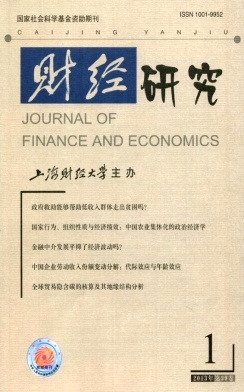全球贸易隐含碳的核算及其地缘结构分析
财经研究 2013 年 第 39 卷第 01 期, 页码:114 - 123
摘要
参考文献
摘要
文章基于GTAP国际投入产出数据,核算了全球不同国家或地区之间的贸易隐含碳量。结果表明:全球贸易隐含碳量巨大,占全球碳排放总量的1/4强;隐含碳流入、流出量存在明显区域差异,中国等金砖国家的净流出量较大,美国、欧盟等则净流入量较大;贸易隐含碳的大小存在特定的地缘结构,分化出三种类型的国家或地区集团,以金砖国家为代表的制造业国是中国在隐含碳问题上的主要谈判合作伙伴,低水平发展中国家反而不是中国的最佳谈判合作伙伴。
[1]樊纲,苏铭,曹静.最终消费与碳减排责任的经济学分析[J].经济研究,2010,(1):4-14.
[2]齐晔,李惠民,徐明.中国进出口贸易中的隐含碳估算[J].中国人口资源与环境,2008,18(3):8-13.
[3]王媛,王文琴,方修琦,等.基于国际分工角度的中国贸易碳转移估算[J].资源科学,2011,33(7):1331-1337.
[4]徐玉高,吴宗鑫.国际间碳转移:国际贸易和国际投资[J].世界环境,1998,(1):24-29.
[5]Ackerman F,Ishikawa M,Suga M.The carbon content of Japan-US trade[J].Energy Policy,2007,35(9):4455-4462.
[6]Bastianoni S,Pulselli F M,Tiezzi E.The problem of assigning responsibility for green-house gas emissions[J].Ecological Economics,2004,49(3):253-257.
[7]Burniaux J M,Truong T P.GTAP-E:An energy-environmental version of the GTAP model[J].GTAP Technical Paper,No.16,2002.
[8]Chen G,Zhang B.Greenhouse gas emissions in China2007:Inventory and input-output analysis[J].Energy Policy,2010,38(10):6180-6193.
[9]Chen Z,Chen G.Embodied carbon dioxide emission at supra-national scale:A coalition analy-sis for G7,BRIC,and the rest of the world[J].Energy Policy,2011,39(5):2899-2909.
[10]Davis SJ,Caldeira K.Consumption-based accounting of CO2emissions[J].Proceedings of the National Academy of Sciences of the USA,2010,107(12):5687-5692.
[11]Hertel TW.Global trade analysis:modeling and applications[M].London:Cambridge University Press,1999.
[12]Lenzen M,Murray J,Sack F,et al.Shared producer and consumer responsibility—The-ory and practice[J].Ecological Economics,2007,61(1):27-42.
[13]Lin B,Sun C.Evaluating carbon dioxide emissions in international trade of China[J].Energy Policy,2010,38(1):613-621.
[14]Liu X,Ishikawa M,Wang C,et al.Analyses of CO2emissions embodied in Japan-China trade[J].Energy Policy,2010,38(3):1510-1518.
[15]McDonald S,Thierfelder K.Deriving aglobal social accounting matrix from GTAP ver-sions5data[R].GTAP Technical Paper No.22,Purdue University,2004.
[16]Munksgaard J,Pedersen K A.CO2accounts for open economies:Producer or consumer responsibility?[J].Energy Policy,2001,29(4):327-334.
[17]Narayanan B G,Walmsley T L.Global Trade,Assistance,and Production:The GTAP 7Data Base[R].Center for Global Trade Analysis,Purdue University,2008.
[18]Nijkamp P,Wang S,Kremers H.Modeling the impacts of international climate change policies in a CGE context:The use of the GTAP-E model[R].Economic modelling,2005,22(6):955-974.
[19]Pan J,Phillips J,Chen Y.China’s balance of emissions embodied in trade:Approaches to measurement and allocating international responsibility[J].Oxford Review of Eco-nomic Policy,2008,24(2):354.
[20]Park S H,Labys W C.Divergences in manufacturing energy consumption between the North and the South[J].Energy Policy,1994,22(6):455-469.
[21]Peters G P,Hertwich E G.Post-Kyoto greenhouse gas inventories:Production versus consumption[J].Climatic Change,2008,86(1):51-66.
[22]Rhee H C,Chung H S.Change in CO2emission and its transmissions between Korea and Japan using international input-output analysis[J].Ecological Economics,2006,58(4):788-800.
[23]Solomon S,Qin D,Manning M,et al.Climate change2007—The physical science basis.Contribution of Working Group I to the fourth assessment report of the Intergovernmental Panel on Climate Change.[M].New York:Cambridge University Press,2007.
[24]Wiedmann T.A review of recent multi-region input-output models used for consumpti on-based emission and resource accounting[J].Ecological Economics,2009,69(2):211-222.
[25]Xu M,Li R,Crittenden J,et al.CO2emissions embodied in China’s exports from2002 to2008:A structural decomposition analysis[J].Energy Policy,2011,39(11):7381-7388.
[2]齐晔,李惠民,徐明.中国进出口贸易中的隐含碳估算[J].中国人口资源与环境,2008,18(3):8-13.
[3]王媛,王文琴,方修琦,等.基于国际分工角度的中国贸易碳转移估算[J].资源科学,2011,33(7):1331-1337.
[4]徐玉高,吴宗鑫.国际间碳转移:国际贸易和国际投资[J].世界环境,1998,(1):24-29.
[5]Ackerman F,Ishikawa M,Suga M.The carbon content of Japan-US trade[J].Energy Policy,2007,35(9):4455-4462.
[6]Bastianoni S,Pulselli F M,Tiezzi E.The problem of assigning responsibility for green-house gas emissions[J].Ecological Economics,2004,49(3):253-257.
[7]Burniaux J M,Truong T P.GTAP-E:An energy-environmental version of the GTAP model[J].GTAP Technical Paper,No.16,2002.
[8]Chen G,Zhang B.Greenhouse gas emissions in China2007:Inventory and input-output analysis[J].Energy Policy,2010,38(10):6180-6193.
[9]Chen Z,Chen G.Embodied carbon dioxide emission at supra-national scale:A coalition analy-sis for G7,BRIC,and the rest of the world[J].Energy Policy,2011,39(5):2899-2909.
[10]Davis SJ,Caldeira K.Consumption-based accounting of CO2emissions[J].Proceedings of the National Academy of Sciences of the USA,2010,107(12):5687-5692.
[11]Hertel TW.Global trade analysis:modeling and applications[M].London:Cambridge University Press,1999.
[12]Lenzen M,Murray J,Sack F,et al.Shared producer and consumer responsibility—The-ory and practice[J].Ecological Economics,2007,61(1):27-42.
[13]Lin B,Sun C.Evaluating carbon dioxide emissions in international trade of China[J].Energy Policy,2010,38(1):613-621.
[14]Liu X,Ishikawa M,Wang C,et al.Analyses of CO2emissions embodied in Japan-China trade[J].Energy Policy,2010,38(3):1510-1518.
[15]McDonald S,Thierfelder K.Deriving aglobal social accounting matrix from GTAP ver-sions5data[R].GTAP Technical Paper No.22,Purdue University,2004.
[16]Munksgaard J,Pedersen K A.CO2accounts for open economies:Producer or consumer responsibility?[J].Energy Policy,2001,29(4):327-334.
[17]Narayanan B G,Walmsley T L.Global Trade,Assistance,and Production:The GTAP 7Data Base[R].Center for Global Trade Analysis,Purdue University,2008.
[18]Nijkamp P,Wang S,Kremers H.Modeling the impacts of international climate change policies in a CGE context:The use of the GTAP-E model[R].Economic modelling,2005,22(6):955-974.
[19]Pan J,Phillips J,Chen Y.China’s balance of emissions embodied in trade:Approaches to measurement and allocating international responsibility[J].Oxford Review of Eco-nomic Policy,2008,24(2):354.
[20]Park S H,Labys W C.Divergences in manufacturing energy consumption between the North and the South[J].Energy Policy,1994,22(6):455-469.
[21]Peters G P,Hertwich E G.Post-Kyoto greenhouse gas inventories:Production versus consumption[J].Climatic Change,2008,86(1):51-66.
[22]Rhee H C,Chung H S.Change in CO2emission and its transmissions between Korea and Japan using international input-output analysis[J].Ecological Economics,2006,58(4):788-800.
[23]Solomon S,Qin D,Manning M,et al.Climate change2007—The physical science basis.Contribution of Working Group I to the fourth assessment report of the Intergovernmental Panel on Climate Change.[M].New York:Cambridge University Press,2007.
[24]Wiedmann T.A review of recent multi-region input-output models used for consumpti on-based emission and resource accounting[J].Ecological Economics,2009,69(2):211-222.
[25]Xu M,Li R,Crittenden J,et al.CO2emissions embodied in China’s exports from2002 to2008:A structural decomposition analysis[J].Energy Policy,2011,39(11):7381-7388.
引用本文
丛晓男, 王铮, 郭晓飞. 全球贸易隐含碳的核算及其地缘结构分析[J]. 财经研究, 2013, 39(1): 114–123.
导出参考文献,格式为:
本期封面
相关论文





 7537
7537  4451
4451

